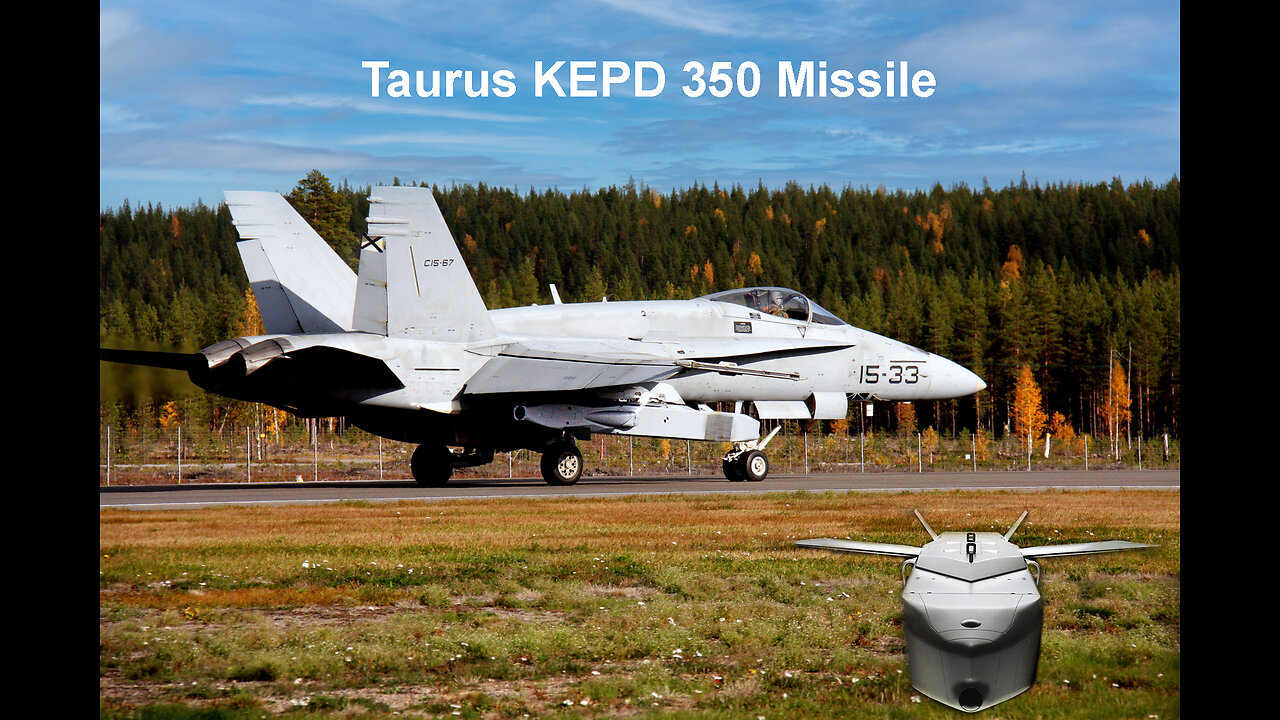Premium Only Content

Taurus KEPD 350 Swedish-German air-launched cruise missile system
Taurus KEPD 350 Swedish-German air-launched cruise missile system
Media reports emerged over the summer that Germany has been stalling the transfer of Taurus missiles out of fear they might be used to strike targets in Russian territory.
The Taurus KEPD 350 is a Swedish-German air-launched cruise missile, manufactured by Taurus Systems and used by Germany, Spain, and South Korea. Taurus Systems GmbH is a partnership between MBDA Deutschland GmbH and Saab Bofors Dynamics.
The advanced TAURUS KEPD 350 is a modular stand-off missile system. It is capable of precision strikes on stationary and semi-stationary targets, including bunkers and other hardened, deeply buried targets, as well as high-value point and area targets, such as large radar stations.
KEPD stands for ‘Kinetic Energy Penetrator and Destroyer.’
The system is a Mobile Technology Control Regime (MTCR) Category II weapon, designed to penetrate thick, hardened air defences via a very low-level terrain following flight. Day or night and in any weather, it neutralizes its targets through its highly effective 481-kilogram dual-stage warhead system, MEPHISTO which is equipped with two laser rangefinders.
.
TAURUS KEPD 350 combines outstanding penetration of hard and deeply buried targets, and blast and fragmentation of high-value point and area targets with exceptional bridge-and-runway-target kill capacity.
With its dual-stage warhead system, the first part is designed to bust through hard or deeply buried targets, the second produces fragmentation damage at a specific level of a building or bunker, thanks to what the manufacturer says is the world's only multi-programmable fuse.
The system remains the only stand-off missile programmable for effect at a specific pre-selected floor. This extraordinary feature is achieved by applying layer counting and void sensing technology.
Each aluminum-skinned KEPD-350 Taurus measures 5.1 meters long and weighs just over 1.4 tons (3,100 pounds.)
Once launched from an aircraft, foldable wings fold-out and along with X-shaped maneuvering tail fins and an American Textron P8300-15 turbofan engine allow the missile to cruise to target at the speed of 740 to 1110 kilometers per hour (460 to 690 miles per hour) to a range of 500 kilometers (310 miles).
A laptop-based mission planning system programs a Taurus flight path of the missile and target reference images pre-mission, making it relatively easy to use it with Soviet Su-24M bombers Ukraine has already adapted to deliver Storm Shadow missiles.
Upon being launched a Tri-tech navigation system of the missile uses multiple sensors and reference libraries to continually track its position and correct its course.
Those include a ground-scanning infrared-imaging sensor, an on-board terrain map library for image-matching navigation, a laser-gyroscope built by Northrop-Grumman for inertial tracking, a radar altimeter for terrain-reference navigation, and a 12-channel jam-resistant GPS receiver.
This allows Taurus strike with precision when GPS signals are jammed.
On the final approach missile flies upward, giving the IR-imaging sensor in a nose of the Taurus a better vantage to search below for a structure matching a 3D model of its pre-assigned target. Once a target is identified, the missile dives at 90 degrees towards it. If the missile can’t find its target, it is programmed to crash somewhere it will not cause collateral damage.
Moments before impact, the missile releases a ‘precursor’ shaped charge weighing 220 pounds that blasts a hole in a hardened structure or underground bunker. That allows the larger 7.5-foot-long penetrator to drop inside.
Thanks to its PIMPF (programmable intelligent multipurpose fuse)–a void-sensing smart fuse, the penetrator itself can be programmed to explode after having pierced through, say, a certain number of floors in an underground facility.
It can also use a two-way datalink to allow for remote control by an operator while it transmits back video imagery. That could enable the use of a missile against moving targets, such as ships or ground vehicle columns.
Unit cost is $1.12 million.
Taurus and Storm Shadow share many similar capabilities, including a stealthy radar cross-section.
The biggest difference is range. The Taurus has more powerful and fuel-efficient turbofan engine.
All three missiles—the British, French and German ones—are similar in size, payload and guidance. All three are subsonic. There are some minor differences in seekers and stealth qualities, but the big difference between the missiles is their respective engines. The Storm Shadow and SCALP have turbojets. The Taurus has a turbofan.
In a turbojet, air travels into the engine, combusts then travels out of the engine. In a turbofan—a more modern engine type—there is a fan in the front of the engine that blows the air through the engine core, making it more efficient for a given weight and power
#eyesontheworld #tauruskepd350 #ukrainewar
-
 LIVE
LIVE
cosmicvandenim
5 hours agoCOSMIC VAN DENIM X TRAGIKxGHOST | DEVOUR | Horror Game
127 watching -
 37:36
37:36
Tactical Advisor
3 hours agoOpening Mystery Box & New Thermal | Vault Room Live Stream 036
18K4 -
 1:23:33
1:23:33
Steve-O's Wild Ride! Podcast
2 days ago $12.32 earnedRainn Wilson and Steve-O Break The Silence On Their Long Friendship | Wild Ride #263
26.3K15 -
 42:40
42:40
The Brett Cooper Show
2 days ago $15.81 earnedWhy Are We Attacking Travis Kelce and Theo Von? | Episode 57
39.4K93 -
 58:30
58:30
X22 Report
5 hours agoMr & Mrs X - RFK Jr Begins Banning Poison Foods, Fauci's Lies Unmasked, D’s Lies Exposed - Ep 3
98.9K27 -
 2:59:21
2:59:21
I_Came_With_Fire_Podcast
7 hours agoPakistan Was Laundering USAID Money to Kill Americans
40K18 -
 2:51:15
2:51:15
JuicyJohns
8 hours ago $13.12 earned🟢#1 REBIRTH PLAYER 10.2+ KD🟢CASH CUSTOMS
165K4 -
 42:08
42:08
SouthernbelleReacts
2 days ago $3.57 earned💥 Friday Night Legends | My First Reaction to Varsity Blues (1999) 🏈 Texas Football Drama Unleashed!
41.2K2 -
 LIVE
LIVE
CHiLi XDD
6 hours ago| Tekken 8 | EWC 2025 Watch Party!
114 watching -
 2:28:16
2:28:16
VapinGamers
6 hours ago $1.52 earnedOff the Grid - Controller Scrub Community Games Saturday - !music !rumbot
31.8K